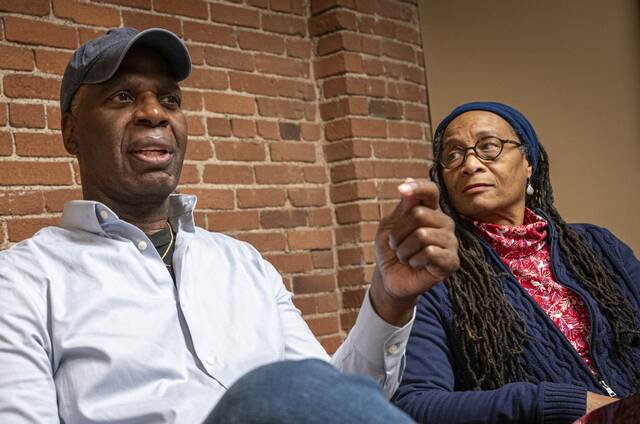Two Ligonier Valley police officers placed themselves, perhaps unnecessarily, in a situation that required deadly force when they fatally shot a Ligonier Township man last month, according to two use-of-force experts.
“What they did is probably not illegal, nor would it warrant a civil suit, but it probably should have been handled differently,” said Dennis Rudovsky, an attorney and founding partner of Kairys, Rudovsky, Messing & Feinberg, a Philadelphia law firm. Rudovsky has been a senior fellow since 1987 with the University of Pennsylvania School of Law, where he teaches courses in constitutional criminal procedure, criminal law and evidence.
He was commenting on police body camera videos, obtained by the Tribune-Review through an open records request, that captured the encounter officers Ryan Hall and James Friscarella had July 2 with Robbie T. Saunders, 59, at his Gravel Hill Road home.
They were called for a report of a domestic disturbance. A female witness outside told them Saunders “woke up crazy” and had a knife. Both officers were on their way up the steps to the front door when Saunders came out holding a 14-inch machete, the video shows.
In a span of less than three seconds, one of the officers commands Saunders to drop the knife and both fire on him, Friscarella with a stun gun and Hall with his service weapon.
The officers declined to comment.
Editor’s note: Video shows Saunders coming out of the house and being shot by police officers.
“From a legal standpoint, those officers were absolutely justified,” said Dennis Marsili, former director of the Indiana University of Pennsylvania’s Criminal Justice Training Center. “I’d commend the officer who used lethal force for firing only one shot. He fired, reassessed the situation and determined very quickly that a second shot was not required.”
Rudovsky agreed.
“They’re permitted to use deadly force if they’re in imminent danger,” Rudovsky said. “And given that (Saunders) raises the machete about head high as he’s coming out, that seems to be the case. But most police departments, today, especially good ones, train on de-escalation, on hostage situations, and they should train on mental health problems.”
Saunders’ son, Army veteran Jonathan Faidley of Centerville, could not be reached for comment for this story but has said his father had a history of drug abuse and had been arrested before when he had a psychotic break.
“If they get a call that this guy is acting out — the woman in the video says he’s acting crazy and the 911 call mentions a knife, so they know what they have,” Rudovsky said. “There’s nobody else in the house, so he can’t harm anyone. So why (immediately approach) the front door? Why not call or have a negotiator come in to talk with him?
“You have the time,” he said.
In Hall’s body camera footage, he and Friscarella can be heard discussing who will carry a nonlethal option and who will carry their service weapon as they begin walking up two short sets of steps to the front door landing.
Friscarella, who is carrying a stun gun and is in front, looks up as he starts up the second set of steps and Saunders opens the storm door. Saunders starts out onto the porch and begins to raise the machete when he is shot by both officers.
A news release from Westmoreland County District Attorney Nicole Ziccarelli recounting the incident and clearing the officers does not mention the use of a stun gun.
Rudovsky said that, given the information officers had from both the 911 call and the witness they spoke with, heading straight to the front door was not necessary.
“A lot of times, there’s nothing you can do, but this isn’t a case where a guy is coming down the street with a gun or a knife,” Rudovsky said. “He was in the house. They had time to think about it.”
Raymond Marr, a use-of-force expert with 13 years of law enforcement experience as a police officer in Braddock, East Pittsburgh and Charleroi, said that, compared with other domestic disturbances he has responded to, the scene outside Saunders’ home seems relatively calm in the video.
“They’re talking to the woman in the driveway, and she seems calm,” he said. “She doesn’t even mention the (knife); the officers have to ask her about it. So that could’ve informed their opinion of the situation.”
Marr said from a tactical standpoint, he would’ve chosen to call out to Saunders from the yard, rather than begin climbing the steps to the front door.
“The way the steps turn, the officer in front is boxed in once he gets to that first landing,” Marr said. “That’s something which, as an officer, would’ve made me uncomfortable. But there aren’t a lot of things that indicate they were going to have trouble with this guy.”
Marr said the department’s familiarity with Saunders — he has had six interactions with police over the past decade — without any major incidents may have led to complacency about the July 2 call.
“It’s happened to me before,” he said. “Sometimes it’s a situation where you’re thinking, ‘Here we go again with this guy,’ and it can be difficult to get police out of that mindset sometimes, where you think it’s just another routine call, and then it turns out not to be.”
Rudovsky said that, as a criminal matter, he agreed with Ziccarelli’s decision to clear both officers but said he was curious whether the officers followed department protocol and current training regarding de-escalation and interaction with people affected by mental illness.
“It would depend on what their protocol is,” he said. “In the cases I see where it goes wrong and someone’s killed, there were often alternatives.”
Marsili said that if they haven’t already taken the training, the department would benefit from a program he used at IUP called “Integrated Communications, Assessments & Tactics,” or ICAT training, developed by the Washington, D.C.-based Police Executive Research Forum.
“We trained on it, and it’s designed for situations where police officers face subjects in mental crisis, who are threatening themselves or someone else, particularly when they’re threatening with something other than a firearm,” Marsili said. “They use what’s called a critical decision-making model alongside the traditional use-of-force continuum, to assess what you should do next.”
The training advises officers to gather as much information as possible, assess the police powers available and determine the next action based on the resistance a person is offering.
“An officer might ask a witness if this has happened before, and if so, how was it resolved?” Marsili said. “If it was resolved successfully, can it be done that way again? Are they on medication, and does the witness or victim know if the person has taken them today?”
Ligonier Valley police Chief Mike Matrunics did not return calls seeking comment.
Marsili said it is difficult to second-guess officers “when you’re not there and you don’t have all the knowledge they may have.”
“I think this situation, though, could certainly be food for thought to other police departments,” he said. “This ICAT training hasn’t really caught on in Pennsylvania, but I really think it should be mandated. I think it could save a lot of lives and a lot of department liability.”








